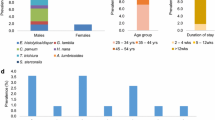Abstract
To determine the prevalence of intestinal parasitic infections in the residents of four Italian psychiatric institutions, we examined the stool specimens collected in triplicate from 238 residents, enrolled between May 1995 and May 1996. Besides, physician and staff nurses provided data about each resident by standardized questionnaires. Parasites were detected in the fecal samples from 128 patients (53.8%). However, in the stool specimens from 106 residents only non-pathogenic protozoa were found (82.8%). Trichuris trichiura ova, Giardia lamblia cysts and trophozoites, Cryptosporidium parvum oocysts, and Balantidium coli cysts were found in the fecal samples from 22 residents (9.2%). B. hominis was the most prevalent parasite. It was detected in the fecal specimens from 97 residents (40.8%). The so-called nonpathogenic amebae were detected in the fecal specimens from 65 residents, though, at the same time, there was no evidence of entamoeba histolytica infection. Twelve residents (5.0%) showed intestinal colonization by nonpathogenic flagellates. All the subjects with T. trichiura infection were housed in the facility of Ancona. Parasites were found in fecal samples from all the 11 residents with behavioural aberrations, but only three of those suffering from intestinal pathogen infection associated to diarrhea. Statistical analyses revealed that the presence of pathogenic parasites in fecal specimens was significantly associated with diarrhea, nausea, vomiting, abdominal pain, fever, behavioural aberrations and nonpathogenic protozoa (p < 0.01), but did not demonstrate any other significant associations between these parasites and the other variables, such as pruritus, mucus or blood in the stools and presence of fecal leukocytes. On the other hand, the presence of nonpathogenic protozoa was significantly related to aberrations such as pica, geophagia, phytophagy, coprophagy, coprophilia and pathogenic parasites (p < 0.01). Data analyses revealed that both pathogenic and nonpathogenic parasites were significantly more common in institutionalized patients than in controls. The rare presence of clinical signs and symptoms in colonized patients represents an important public health problem, since the presence of asymptomatic carriers among residents with low hygienic conditions, raises concern of transmission of parasitic infections to professional staff and other residents. Since the eradication of parasitic colonization in residential facilities is hard to reach, an effective prevention is the only measure to deal with this public health problem.
Similar content being viewed by others
References
Braun T, Fekete T, Lynch A. Strongyloidiasis in an institution for mentally retarded adults. Arch Intern Med 1988; 148: 634–636.
Huminer D, Symon K, Groskop FI, Pietrushka D, Kremer I, Schantz PM, Pitlik SD. Seroepidemiologic study of toxocariasis and strongyloidiasis institutionalized mentally retarded adults. Am J Trop Med Hyg 1992; 46(3): 278–281.
Jeffery GM. A three-year epidemiologic study of intestinal parasites in a selected group of mental patients. Am J Hyg 1960; 71: 1–8.
Markell EK, Udkow MP. Blastocystis hominis: Pathogen or fellow traveler? Am J Trop Med Hyg 1986; 24: 548–550.
Miller RA, Minshew BH. Blastocystis hominis: An organism in search of a disease. Rev Infect Dis 1988; 10: 930–938.
Naiman HL, Sekla L, Albritton WL. Giardiasis and other intestinal parasitic infections in a Manitoba residential school for the mentally retarded. Can Med Assoc J 1980; 122: 185–188.
Ong SL, Cheng MY, Liu KH, Lee SY, Chow LP, Cheng TL, Lan CF, Chang YS, Horng CB. Parasitic infection in a psychiatric institution in Taiwan, with special reference to Entamoeba histolytica. Epidemiol Bullet 1995; 11: 107–110.
Ong SJ, Cheng MY, Liu KH, Horng CB. Use of the proSpec T microplate enzyme immunoassay for the detection of pathogenic and non-pathogenic Entamoeba histolytica in faecal specimens. Trans R Soc Trop Med Hyg 1996; 248–249.
Reardon LV. Incidence of Entamoeba histolytica and intestinal nematodes in a Georgia state institution. J Parasitol 1941; 27: 89–90.
Rolston KVI, Hoy J, Mansell PWA. Diarrhea caused by ‘nonpathogenic amoebae’ in patients with AIDS. N Eng J. Med 1986; 315: 192.
Rolston KVI, Winans R, Rodriguez S. Blastocystis hominis: Pathogen or not? Rev Infect Dis 1989; 11: 661–662.
Ryan NJ, Sutherland G, Coughlan K, Globan M, Doultree J, Marshall J, Baird RW, Pedersen J, Dwyer B. A new trichrome-blue stain for detection of microsporidial species in urine, stool, and nasopharyngeal specimens. J Clin Microbiol 1993; 31: 3264–3269.
Scaglia M, Gatti S, Bruno A, Cevini C, Marchi L, Sargeaunt PG. Autochthonous amoebiasis in institutionalized mentally-retarded patients: Preliminary evaluation of isoenzyme patterns in three isolates. An Trop Med Parasitol 1991; 85(5): 509–513.
Senay H, MacPherson D. Blastocystis hominis: Epidemiology and natural history. J Infect Dis 1990; 162: 987–990.
Sexton DJ, Krogstad DJ, Spencer HC Jr, Healy GR, Sinclair S, Sledge CE, Schultz MG. Amebiasis in a mental institution: Serologic and Epidemiologic studies. Am J Epidemiol 1974; 100: 414–423.
Sheehan DJ, Raucher BG, McKitirick JC. Association of Blastocystis hominis with signs and symptoms of human disease. J Clin Microbiol 1986; 24: 548–550.
Thacker SB, Simpson S, Gordon TJ, Wolfe M, Kimball AM. Parasitic disease control in a residential facility for the mentally regarded. Am J Public Health 1979: 69: 1279–1281.
Thacker SB, Kimball AM, Wolfe M, Choi K, Gilmore L. Parasitic disease control in a residential facility for the mentally retarded: Failure of selected isolation procedures. Am J Public Health 1981; 71: 303–305.
Zierdt CH. Blastocystis hominis, a protozoan parasite and intestinal pathogen of human beings. Clin Microbiol News 1983; 5: 57–79.
Zierdt CH. Blastocystis hominis as a human pathogen. Rev Infect Dis 1989; 11: 661.
Author information
Authors and Affiliations
Rights and permissions
About this article
Cite this article
Giacometti, A., Cirioni, O., Balducci, M. et al. Epidemiologic features of intestinal parasitic infections in Italian mental institutions. Eur J Epidemiol 13, 825–830 (1997). https://doi.org/10.1023/A:1007306630301
Issue Date:
DOI: https://doi.org/10.1023/A:1007306630301



